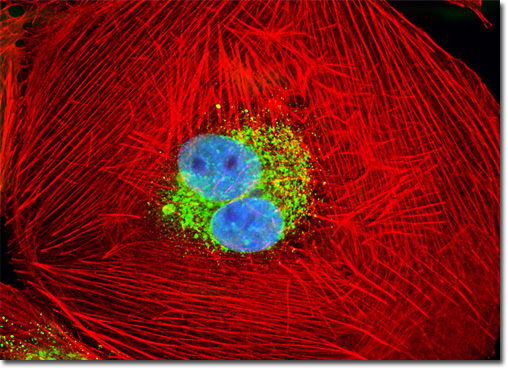Fluorescence Digital Image Gallery
Normal African Green Monkey Kidney Fibroblast Cells (CV-1)
|
Fibroblasts, such as those that comprise the CV-1 cell line, form from the mesenchyme, a network of unspecialized stellate cells loosely packed in a gelatinous ground substance, during embryonic development. Postnatally, some fibroblasts are also produced when needed by a small number of mesenchymal cells that persist in the body after birth within the walls of small blood vessels and other areas. This activity is most likely to occur when a tissue or organ becomes damaged, since fibroblasts play a central role in the healing process. Indeed, fibroblasts are extremely important for their involvement in the production of the fibrous protein collagen, which is the substance that chiefly comprises scar tissue. Though a necessary aspect of body repair, scar tissue is typically inferior in quality to the tissue it replaces, since it lacks hair follicles, sweat glands, and is more susceptible to the effects of ultraviolet radiation. The digital image presented above exhibits a culture of CV-1 fibroblast cells that was stained with wheat germ agglutinin conjugated to Oregon Green 488, Alexa Fluor 568 conjugated to phalloidin, and DAPI, which selectively bind to the intracellular Golgi network, cytoskeletal actin filaments, and nuclei, respectively. Note the presence of high signal levels, with sharp definition, from all three of the fluorophores employed to stain the specimen. Images were recorded in grayscale with a QImaging Retiga Fast-EXi camera system coupled to an Olympus BX-51 microscope equipped with bandpass emission fluorescence filter optical blocks provided by Omega Optical. During the processing stage, individual image channels were pseudocolored with RGB values corresponding to each of the fluorophore emission spectral profiles. |
© 1995-2025 by Michael W. Davidson and The Florida State University. All Rights Reserved. No images, graphics, software, scripts, or applets may be reproduced or used in any manner without permission from the copyright holders. Use of this website means you agree to all of the Legal Terms and Conditions set forth by the owners.
This website is maintained by our
|
